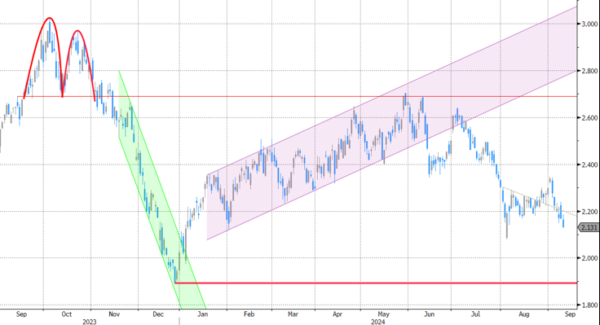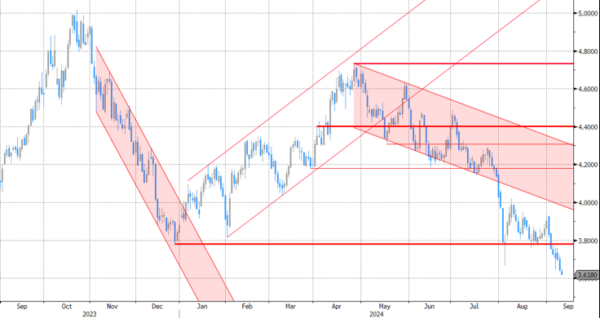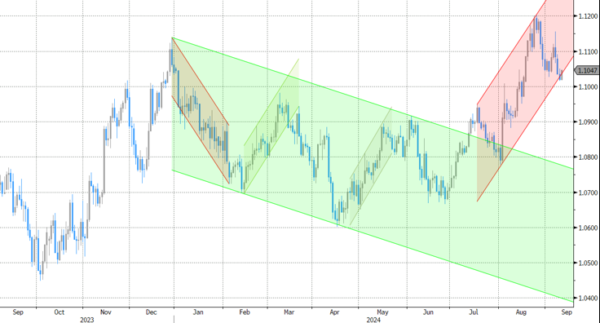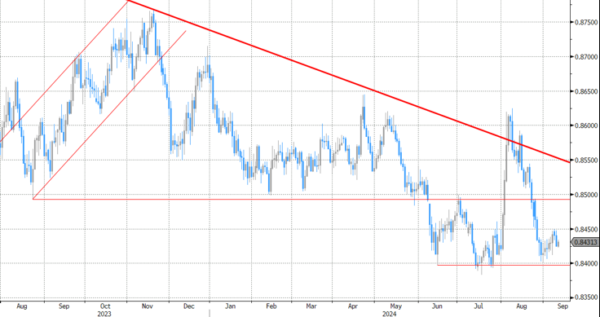Markets
Momentum changed yesterday from the US opening as core bonds steamed ahead. The move was triggered by another sudden drop in oil prices. Brent crude prices opened around $72/b, but a break below the recent lows ($70.6 area) accelerated the downleg with an intraday low near $68.5/b. Commodity prices like oil or iron ore keep sending alarms on the global state of the economy. Investors pile up on central bank easing bets, especially in the US, and recession wagers. Bull steepening is the obvious outcome. A very strong $58bn 3-yr Note auction added to the curve move. The auction stopped a significant 1.7 bps below the WI yield with a very aggressive indirect bid and a rising overall auction bid cover (2.66). US yields dropped 3.8 bps (30-yr) to 7.4 bps (2-yr) yesterday. From a technical point of view, the US 2-yr yield arrived at the 2023 low of 3.55%. However, in the current market setting we don’t expect that to play a role. With Fed entering a new phase in its monetary policy cycle, the bottom for the front end of the curve will be defined in first instance by the (market) view on neutral rates (3% area). The US 10-yr yield lost the final support in the 3.66%/3.78%-zone and is now on its way back to the 2023 low of 3.25% which coincides with 38% retracement on the race from 0.31% to 5.02% between 2020 and 2023. US Treasuries continued to outperform German Bunds with German yields ending 2.6 bps (30-yr) to 4.1 bps (5-yr) lower. That makes sense given the approaching ECB meeting and the fact that the Lagarde & co have way less space to make policy less restrictive compared to the Fed. On top, the European inflation outlook doesn’t support the case for rapid or large rate cuts. The dollar’s technical comeback immediately ran into first resistance. Lower oil prices and the loss of interest rate support obviously aren’t helping. The US presidential debate might have added to the move this morning. We argued before that Trump momentum went hand-in-hand with by default USD-momentum as it implied an aggressive trade policy in the disadvantage of the likes of EMU, China,… . Democratic Nominee Harris’ strong performance the debate triggered some reverse action. EUR/USD rebounds towards 1.1044 this morning.
The August US CPI report grabs most attention today. Consensus expects 0.2% M/M price growth for both headline and core inflation resulting in a Y/Y headline CPI drop from 2.9% to 2.5% and a stabilization at 3.2% for the core gauge. We don’t think that inflation data even in case of an upward surprise will be able to alter ruling market momentum. Especially should risk sentiment sour further. A negative surprise will even add to 50 bps rate cuts bets going into next week’s FOMC meeting, our preferred scenario.
News & Views
The Japanese yen is taking a leap this morning. USD/JPY slips towards the 141 lever with a test of the December 2023 low (140.25) increasingly probably. JPY strength dominates the G10 FX landscape following comments from Bank of Japan board member Nakagawa. Having gained a dovish reputation over the years, Nakagawa this time struck a different tone. She said that policy normalization would continue if the outlook for the economy and inflation materializes, echoing comments made by other BoJ members including governor Ueda. Risk number one for Nakagawa is the upside one to inflation with chances that wage growth will deviate from the BoJ scenario due to a tight labour market. Especially her comments about the “extremely low” real rates gained a lot of market attention. They suggest Nakagawa believes there is room for several rate hikes. The central bank meets September 20 but a third hike already then is unlikely after the unexpected July one.
US households’ real, inflation-adjusted, incomes rose in 2023 for the first time since 2019, the Census Bureau’s annual report unveiled yesterday. Household income rose throughout the income distribution with median incomes increasing some 4% to $86 610. The rise reflected a sharp drop in inflation, which eased from an annual 8% in 2022 to 4.1% last year. Despite the increase, median incomes remain some $600 below the pre-pandemic levels. Census also reported that the country’s main gauge of the poverty rate (adjusted for government support including food assistance and tax credits) rose to 12.9%, up from 12.4% in 2022. The official poverty rate dropped to 11.1%, 0.6 ppts above the record low seen in 2019.
Graphs
GE 10y yield
The ECB cut policy rates by 25 bps in June. Stubborn inflation (core, services) make follow-up moves less evident. Markets nevertheless price in two to three more cuts for 2024 as disappointing US and unconvincing EMU activity data rolled in, dragging the long end of the curve down. The move accelerated during the early August market meltdown.
US 10y yield
The Fed in its July meeting paved the way for a first cut in September. It turned attentive to risks to the both sides of its dual mandate as the economy is moving to a better in to balance. The pivot weakened the technical picture in US yields. A string of weak eco data and a risk-off market climate pushed and kept the 10-yr sub 4%. We think we could be up to three 50 bps rate cuts this year.
EUR/USD
EUR/USD moved above the 1.09 resistance area as the dollar lost interest rate support at stealth pace. US recession risks and bets on fast and large rate cuts trumped traditional safe haven flows into USD. EUR/USD 1.1276 (2023 top) serves as next technical references.
EUR/GBP
The BoE delivered a hawkish cut in August. Policy restrictiveness will be further unwound gradually on a pace determined by a broad range of data. The strategy similar to the ECB’s balances out EUR/GBP in a monetary perspective. Recent better UK activity data and a cautious assessment of BoE’s Bailey at Jackson Hole are pushing EUR/GBP lower in the 0.84/0.086 range.
















